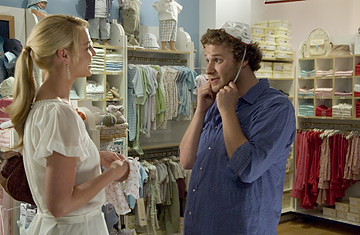
Alison Scott (Katherine Heigl) and Ben Stone (Seth Rogen) shop for baby clothes in Knocked Up.
(2 of 5)
Watching the movie with a theater full of actual paying customers (who gave every indication of enjoying themselves), I laughed here and there, didn't build up a raging animosity. But I was very much on the outside of the experience. I felt like an entomologist observing some strange, yet strangely familiar new species. Then I realized what I was seeing: a 1930s movie in contemporarily grungy garb. And I don't mean that as a compliment to Knocked Up — that it has a clever plot or dazzling dialogue. Long ago I wrote a book on Hollywood screenwriters (the 1974 Talking Pictures), and in that spirit I have one or two tuts to tut.
Knocked Up is, essentially, a rich-girl-poor-boy romantic comedy, of the kind Hollywood manufactured by the hundreds in its glamorous, sexually restrictive prime. Back then, an unmarried woman with a baby would usually be the victim of mistaken identity. Ginger Rogers, say, in the 1939 Bachelor Mother: she notices an abandoned infant outside an orphanage, gathers the child up and is thought to be its mother; comic discomfort ensues. On rare occasions, and with back-breaking dexterity, a gifted writer could work the sex act into a movie's plot. Preston Sturges' The Miracle of Morgan's Creek: on a one-night stand, a pretty young blond gets drunk and pregnant, and drags her very unsuitable boyfriend along to help her cope with the consequences. Hilarity, at breakneck speed and daredevil heights, ensues.
The difference back then, kids, was the iron-clad code of behavior imposed on movie characters. No sexual union without marriage was condoned; no woman blithely chose to have a child out of wedlock; abortion (or, as it's delicately alluded to in Knocked Up, "shmuh-shmortion") was not considered, not even discussed. Considering all the strictures on what was allowed in movies, we marvel at the ingenuity of writers to confect situations that satisfied audiences then, and still delight us today, if only in their gleaming artificiality.
Apatow labors under none of those caveats. Marriage is an option, not a command, for couples living together; nearly 40% of all babies born in 2005 had unmarried mothers; more than a million legal abortions are performed each year in the U.S. So Apatow, like all modern comedy writers, has another challenge: how to create social and ethical barriers — the ones the old screenwriters relied on for their characters to hurdle — when few exist. His tactic: rebuild the old barriers. If those hobbling conventions worked for the old masters, they might be worth resuscitating.
